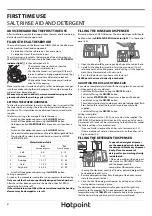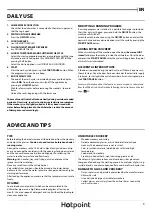
5
EN
DAILY USE
1. CHECK WATER CONNECTION
Check that the dishwasher is connected to the water supply and
that the top is open.
2. SWITCH ON THE DISHWASHER
Press the
ON/OFF
button.
3. LOAD THE RACKS
(see LOADING THE RACKS)
4. FILLING THE DETERGENT DISPENSER
(see PROGRAMS TABLE).
5. CHOOSE THE PROGRAM AND CUSTOMISE THE CYCLE
Select the most appropriate program in accordance with the type
of crockery and its soiling level
(see PROGRAMS DESCRIPTION)
by
pressing the
P
button.
Select the desired options
(see OPTIONS AND FUNCTIONS)
.
6. START
Start the wash cycle by pressing the
START/PAUSE
button. When
the program starts you hear a beep.
7. END OF WASH CYCLE
The end of the wash cycle is indicated by beeps and the display
shows
END
. Open the door and switch off the appliance by
pressing the
ON/OFF
button.
Wait for a few minutes before removing the crockery - to avoid
burns.
Unload the racks, beginning with the lower one.
The machine will switch off automatically during certain extended
periods of inactivity, in order to minimise electricity consumption.
If the crockery is only lightly soiled or if it has been rinsed with
water before being placed in the dishwasher, reduce the amount
of detergent used accordingly.
MODIFYING A RUNNING PROGRAM
If a wrong program was selected, it is possible to change it, provided
that it has only just begun: press and hold the
ON/OFF
button, the
machine will switch off.
Switch the machine back on using the
ON/OFF
button and select the
new wash cycle and any desired options; start the cycle by pressing the
START/PAUSE
button.
ADDING EXTRA CROCKERY
Without switching off the machine, open the door
(be ware of HOT
steam!)
and place the crockery inside the dishwasher. Close the door
and press the
START/PAUSE
button the cycle will begin from the point
at which it was interrupted.
ACCIDENTAL INTERRUPTIONS
If the door is opened during the wash cycle, or if there is a power cut,
the cycle stops. Once the door has been closed or the electricity supply
is restored, to start again the cycle from where it was interrupted, press
the
START/PAUSE
button.
For more information about the functions, you can request or download
from the WEB a Use & Care Guide by following the instructions on the last
page.
ADVICE AND TIPS
TIPS
Before loading the baskets, remove all food residues from the crockery
and empty the glasses.
You do not need to rinse beforehand under
running water.
Arrange the crockery so that it is held in place firmly and does not tip
over; and arrange the containers with the openings facing downwards
and the concave/convex parts placed obliquely, thus allowing the
water to reach every surface and flow freely.
Warning:
lids, handles, trays and frying pans do not prevent the
sprayer arms from rotating.
Place any small items in the cutlery basket.
Very soiled dishes and pans should be placed in the lower basket
because in this sector the water sprays are stronger and allow a higher
washing performance.
After loading the appliance, make sure that the sprayer arms can rotate
freely.
HYGIENE
To avoid odour and sediment which can be accumulated in the
dishwasher please run a high temperature program at least one a
month. Use a tea spoon of detergent and run it without the loading to
clean your appliance.
UNSUITABLE CROCKERY
•
Wooden crockery and cutlery.
•
Delicate decorated glasses, artistic handicraft and antique
crockery. Their decorations are not resistant.
•
Parts in synthetic material which do not withstand high
temperatures.
•
Copper and tin crockery.
•
Crockery soiled with ash, wax, lubricating grease or ink.
The colours of glass decorations and aluminium/silver pieces can
change and fade during the washing process. Some types of glass (e.g.
crystal objects) can become opaque after a number of wash cycles too.
DAMAGE TO GLASS AND CROCKERY
•
Only use glasses and porcelain guaranteed by the manufacturer as
dishwasher safe.
•
Use a delicate detergent suitable for crockery
•
Collect glasses and cutlery from the dishwasher as soon as the
wash cycle is over.








